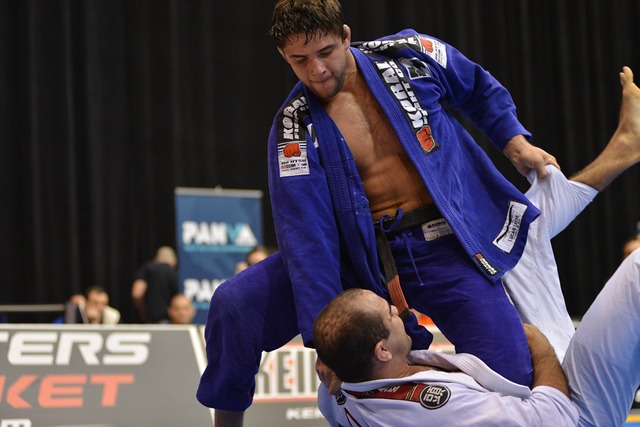
Out of the many uncomfortable positions that BJJ has to offer, there’s one that remains above them all. No matter how many new ways grapplers imagine to torture each other in training, nothing beats the knee on belly position. A far as discomfort, pressure, and sadism go, knee on belly is the peak. This position ensures that you keep your opponent under enormous crushing pressure while you do…well, nothing. the idea is to keep them struggling until they give away a submission for free. It’s like taking candy from a baby. Perhaps even easier, provided you understand how to be heavier than a mountain from knee on belly.
The first thing to understand about the knee on belly position is that it is not a position of safety. Structurally, it offers a way out for your opponent, so you should always be ready to switch. The bonus is that you either get it on the opposite side or transition to a superior attacking position. Wherever you end up, you’re still going to dominate. Another great aspect is the submission options. Everything from chokes, armbars all the way to heel hooks can be set up from the knee on belly. Just take a look at the success Lucas Lepri has had with it, and he’s only a lightweight!
How To Maintain The Knee On Belly Position
Most lower belts are very familiar with the crushing and inescapable pressure from their instructors and/or higher belts. The knee on belly position is unlike any other side control variation. In fact, it is considered a position on its own and earns 2 points under IBJJF rules if you can hold it for 3 seconds. It is extremely effective and easy to get to. The low risk-high return principle is why most higher belts tend to favor this position over other “more” dominant ones.
The knee on the belly can be dated back to Judo, where it is known as uki gatame or ‘the floating hold’. This is actually a perfect name for the position and should be the goal when looking to master it. The ability to float and smoothly transition while maintaining pressure is a sign of very advanced grapplers.
Structurally, the only points of contact from this position are the shin of one of your legs and the palms. While using the shin across the hips is an effective form of control, it does limit your movement and weight distribution capabilities. It is far better to have the shin across their belly, at an angle that puts your knee at their sternum. Grip placement varies according to the situation. Gi or No-Gi, there are a lot of grips available to control, transition or attack from the knee on belly.
If you’re using this position correctly then you’re driving down into your opponent with all your weight. The goal is to make it hard for them to breathe and force them to present openings for submissions.
Getting Into The Position
The knee on belly position mainly serves as a form of transitionary dominant control. What this means is that it is often used as a link between the other dominant top positions. In order to successfully use it in such a manner, we have to understand how exactly to enter into the position in the first place.
You can enter the position from a wide variety of scenarios. It is a great pit-stop on your way to mount after a throw or a guard pass. You could also enter with ease from any side control variation. For more advanced players, even retreating from mount is an option, when you want to maintain a high level of mobility while still placing tremendous pressure on the opponent.
With a knee on belly, the focus is more on transitions in response to your opponent as opposed to a pinning control. Further, many guards passes end up directly in the knee on belly position. Switching from one side to another is what everyone looking to maintain the position should master. this is going to keep your in control while tiring our your opponent. The crucial things are timing and weight distribution. same side-to-side knee on belly switch in a different way.
There are no right or wrong ways of going into or out of the position. However, keep in mind that some ways offer you great control, while others afford you mobility. Using them under the correct circumstances is what truly matters and brings results. When you run into someone who is so tough they can endure the position without giving in is where transitions come into play.
Knee On Belly Submissions
If you are a submission hunter, the knee on belly position has to be in your arsenal. There are many high percentage submissions from there, particularly with the gi. Armbars, both near and far- side and readily available with next to no effort. Chokes, like the baseball choke, triangles, and other lapel chokes are also quite standard for the position. For those braver, and mostly doing No-Gi, there are also great entries into Ashi Garami positions that result in tight leg locks. All in all, if you like to finish off your opponent, then knee on belly posting is for you.
The triangle choke from the knee on belly position is one of the most effective submissions available. This move is best used as a sneak attack. It is unorthodox in nature and will catch many opponents by surprise.
For a sneaky and powerful attack, you should always be open to a good lapel choke when in the knee on belly. The Samurai choke, Brabo, baseball choke or even simple collar choke variations are all available.
When looking for an armbar, it is of the utmost importance to make sure you isolate the limb as best you can. The position offers great stability that allows you to slide into position easily when you know what you’re doing.
Don’t stress if you don’t know much about the position when you start to experiment with it. Mastering the knee on belly position takes practice but it has a great return. It’s one of those “basic” but advanced techniques that is very often the deciding factor in a match. So, get out there and start drilling the position!


![Darce Choke Encyclopedia – Origins, Mechanics and Variations [2025] BJJ, choke, Brabo, BJJ Darce Choke, D'arce Choke, Darce BJJ Choke](https://bjj-world.com/wp-content/uploads/2017/11/JungPoirierLeeYahoo-218x150.jpg)















![Slicin’ Calves Mikey Musumeci DVD Review [2025] Slicin' Calves Mikey Musumeci DVD Review](https://bjj-world.com/wp-content/uploads/2025/04/slicin-calves-mikey-musumeci-dvd-review-218x150.png)
![Jiu-Jitsu For Old Guys Guard Retention Bernardo Faria DVD Review [2025] Jiu-Jitsu For Old Guys Guard Retention Bernardo Faria DVD Review](https://bjj-world.com/wp-content/uploads/2025/03/old-guys-guard-retention-bernardo-faria-dvd-review-218x150.png)
![X-Guard Trickery Kyle Sleeman DVD Review [2025] X-Guard Trickery Kyle Sleeman DVD Review](https://bjj-world.com/wp-content/uploads/2025/03/x-guard-trickery-kyle-sleeman-dvd-review-218x150.png)
![Countering with Crab Ride Anthony Budion DVD Review [2025] Countering with Crab Ride Anthony Budion DVD Review](https://bjj-world.com/wp-content/uploads/2025/03/countering-with-crab-ride-anthony-budion-dvd-review-218x150.png)
![Unpinnable Mount Escape Mastery Haleem Syed DVD Review [2025] Mount Escape Mastery Haleem Syed DVD Review](https://bjj-world.com/wp-content/uploads/2025/01/mount-escape-mastery-haleem-syed-dvd-review-324x235.png)
![Slicin’ Calves Mikey Musumeci DVD Review [2025] Slicin' Calves Mikey Musumeci DVD Review](https://bjj-world.com/wp-content/uploads/2025/04/slicin-calves-mikey-musumeci-dvd-review-100x70.png)

![Ginastica Natural Alvaro Romano DVD Review [2024] Ginastica Natural Alvaro Romano DVD Review](https://bjj-world.com/wp-content/uploads/2024/12/ginastica-natural-alvaro-romano-dvd-review-100x70.png)


![Baby Shark Guard System Diogo Reis DVD Review [2025] Baby Shark Guard System Diogo Reis DVD Review](https://bjj-world.com/wp-content/uploads/2025/02/baby-shark-guard-system-diogo-reis-dvd-review-100x70.png)
![Just Pass Jay Rodriguez DVD Review [2024] Just Pass Jay Rodriguez DVD Review](https://bjj-world.com/wp-content/uploads/2024/11/just-pass-jay-rodriguez-dvd-review-100x70.png)
![Guard Busters Bill Cooper BJJ DVD Review [2025] Guard Busters Bill Cooper BJJ DVD Review](https://bjj-world.com/wp-content/uploads/2025/03/guard-busters-bill-cooper-bjj-dvd-review-100x70.png)
![Eoghan O’Flanagan Bundle Down Right Sloppy Jiu-Jitsu Review [2024] Eoghan O'Flanagan Bundle Down Right Sloppy Jiu-Jitsu Review 2024](https://bjj-world.com/wp-content/uploads/2024/09/down-right-sloppy-jiu-jitsu-eoghan-oflanagan-bundle-100x70.png)

![Advantage Over Time Outside Passing Jozef Chen DVD Review [2025] Advantage Over Time Outside Passing Jozef Chen DVD Review](https://bjj-world.com/wp-content/uploads/2025/03/outside-passing-jozef-chen-dvd-review-100x70.png)
![Forging The De La Riva Guard Giancarlo Bodoni DVD Review [2025]](https://bjj-world.com/wp-content/uploads/2025/02/de-la-riva-guard-giancarlo-bodoni-dvd-review-100x70.png)
![Assassin Choke Baret Yoshida DVD Review [2024] Assassin Choke Baret Yoshida DVD Review](https://bjj-world.com/wp-content/uploads/2024/10/assassin-choke-baret-yoshida-dvd-review-100x70.png)
![Zen Guide To Submission Grappling Margot Ciccarelli DVD Review [2025] Zen Guide To Submission Grappling Margot Ciccarelli DVD Review](https://bjj-world.com/wp-content/uploads/2025/02/submission-grappling-margot-ciccarelli-dvd-preview-100x70.png)

![The Whole Omoplata Enchilada Lyanne Perez DVD Review [2024] The Whole Omoplata Enchilada Lyanne Perez DVD Review](https://bjj-world.com/wp-content/uploads/2024/11/whole-omoplata-enchilada-lyanne-perez-dvd-review-100x70.png)
![Slip N Slide Into Victory Julián Espinosa DVD Review [2025] Slip N Slide Into Victory Julián Espinosa DVD Review](https://bjj-world.com/wp-content/uploads/2025/01/slip-n-slide-into-victory-julian-espinosa-dvd-review-100x70.png)
![Modern Split Squat Passing Jason Rau DVD Review [2024] Modern Split Squat Passing Jason Rau DVD Review](https://bjj-world.com/wp-content/uploads/2024/11/modern-split-squat-passing-jason-rau-dvd-review-100x70.png)
![Kill The Underhook Dima Murovanni DVD Review [2024] Kill The Underhook Dima Murovanni DVD Review](https://bjj-world.com/wp-content/uploads/2024/10/kill-the-underhook-dima-murovanni-dvd-review-100x70.png)


![Dynamic Headquarters Passing Jason Rau DVD Review [2024] Dynamic Headquarters Passing Jason Rau DVD Review](https://bjj-world.com/wp-content/uploads/2024/10/dynamic-headquarters-passing-jason-rau-dvd-review-100x70.png)
![Mastering The Crucifix Alexandre Pereira DVD Review [2025] Mastering The Crucifix Alexandre Pereira DVD Review](https://bjj-world.com/wp-content/uploads/2025/01/mastering-the-crucifix-alexandre-pereira-dvd-review-100x70.png)

![Special K Guard Neil Melanson DVD Review [2025] Special K Guard Neil Melanson DVD Review](https://bjj-world.com/wp-content/uploads/2025/03/special-k-guard-neil-melanson-dvd-review-100x70.png)

![Tiny Woman Guide To The Guard Ann Kneib DVD Review [2024] Tiny Woman Guide To The Guard Ann Kneib DVD Review](https://bjj-world.com/wp-content/uploads/2024/11/tiny-woman-guide-to-the-guard-ann-kneib-dvd-review-100x70.png)
![Bricks Kesa Gatame System Jeremy Brick DVD Review [2025] Bricks Kesa Gatame System Jeremy Brick DVD Review](https://bjj-world.com/wp-content/uploads/2025/02/bricks-kesa-gatame-system-jeremy-brick-dvd-review-100x70.png)
